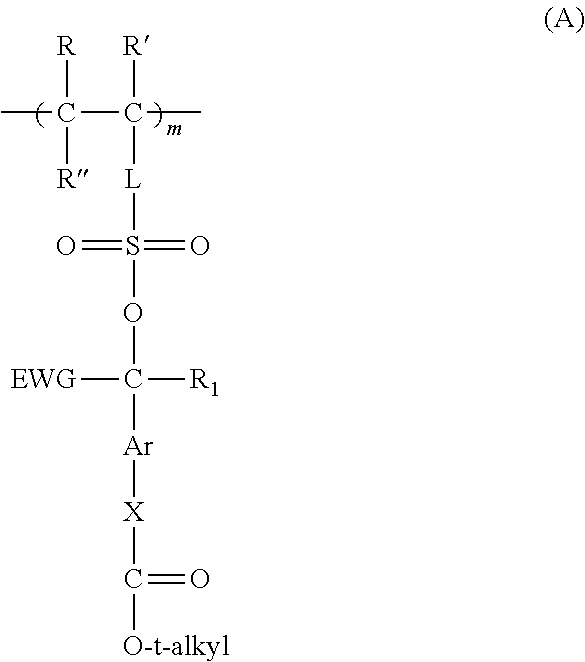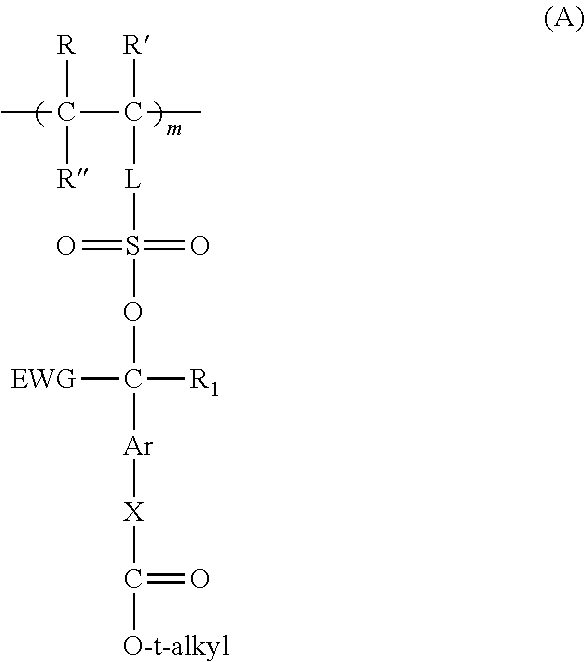Forming electrically-conductive patterns using crosslinkable reactive polymers
- Summary
- Abstract
- Description
- Claims
- Application Information
AI Technical Summary
Benefits of technology
Problems solved by technology
Method used
Image
Examples
invention example 1
Preparation of a Reactive Polymer A from 3-[(4-t-butoxycarbonyloxy)-α-trifluoromethylbenzylsulfo]propyl methacrylate and glycidyl methacrylate in an 85:15 mol Ratio
[0484]3-[(4-t-Butoxycarbonyloxy)-α-trifluoromethylbenzylsulfo]propyl methacrylate monomer prepared above (2.05 g) and 0.11 g of glycidyl methacrylate were weighed out in a 100 ml single-neck round bottom flask and then dissolved in THF and chloroform to obtain a 20 weight % solids solution. With solution still cloudy, 0.03 g of 2,2′-azodi(2-methylbutyronitrile) (AMBN) initiator was added and the reaction solution was purged with nitrogen for about 30 minutes, capped with a septum, and placed in a preheated oil bath at 65° C. overnight. The reaction solution cleared during heating and was cooled and precipitated into ethanol, filtered, and dried. The resulting white solid was then dissolved in THF, precipitated into ethanol, filtered, and dried in a high vacuum oven at room temperature overnight. The resulting Reactive Pol...
invention example 2
Preparation of Reaction Polymer B from 3-[(4-t-butoxycarbonyloxy)-α-trifluoromethylbenzylsulfo]propyl methacrylate, glycidyl methacrylate, and t-butyl methacrylate (64:15:21 mol Ratio)
[0488]3-[(4-t-Butoxycarbonyloxy)-α-trifluoromethylbenzylsulfo]propyl methacrylate monomer prepared above (3.85 g), 0.37 g of t-butyl methacrylate, and 0.27 g of glycidyl methacrylate were weighed out in a 100 ml single-neck round bottom flask and then dissolved in THF to obtain a 25 weight % solids solution. Then, 0.061 g of 2,2′-azodi(2-methylbutyronitrile) (AMBN) initiator was added and the reaction solution was purged with nitrogen for about 30 minutes, capped with a septum, and placed in a preheated oil bath at 65° C. overnight. The reaction solution cleared during heating and was cooled and precipitated into ethanol, filtered, and dried. The resulting white solid was then dissolved in THF, precipitated into ethanol, filtered, and dried in a high vacuum oven at room temperature overnight. The resul...
invention examples 3 and 4
Preparation of Reactive Composition Films and Electrically-Conductive Copper Patterns
[0489]Reactive Polymers A (for Invention Example 3) and B (for Invention Example 4) described above were dissolved in MEK to form 5 weight % reactive compositions along with 0.2 weight % of (methylphenyl)diphenylsulfonium triflate salt (a monomer unit to onium salt molar ratio of 25:1). Each of the resulting reactive compositions was filtered and spin coated at 1200 RPM onto a substrate formed from poly(ethylene terephthalate) film with a polymeric adhesion layer of a polymer derived from glycidyl methacrylate and butyl acrylate that was applied before stretching as previously described, to form polymeric films on the substrate.
[0490]Each of the resulting precursor articles was exposed to short ultraviolet light through a chrome-on-quartz contact mask for 30 seconds, followed by contact with a vacuum hotplate at 110° C. for 1 to 2 minutes. Each resulting intermediate article was then immersed in a 0...
PUM
 Login to View More
Login to View More Abstract
Description
Claims
Application Information
 Login to View More
Login to View More - R&D
- Intellectual Property
- Life Sciences
- Materials
- Tech Scout
- Unparalleled Data Quality
- Higher Quality Content
- 60% Fewer Hallucinations
Browse by: Latest US Patents, China's latest patents, Technical Efficacy Thesaurus, Application Domain, Technology Topic, Popular Technical Reports.
© 2025 PatSnap. All rights reserved.Legal|Privacy policy|Modern Slavery Act Transparency Statement|Sitemap|About US| Contact US: help@patsnap.com



